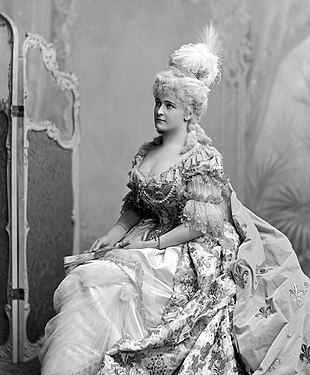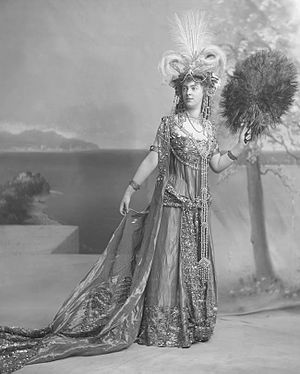Devonshire House Ball of 1897
The Devonshire House Ball or the Devonshire House Fancy Dress Ball was an elaborate
Event
In 1897, The
Following the death of
While the Queen did not attend, almost all of the British royal family attended the ball and nearly every other European royal family was represented.[8] The Duke of Devonshire invited the London photographic firm of James Lafayette,[9] who had been awarded a Royal Warrant ten years previously, to set up a tent (in the garden behind the house) to photograph the guests in costume during the Ball.[6] In 1899, the studio of Walker & Boutal published 286 of the Lafayette photographs.[10][11]
Following the ball, the Duchess received a letter from
Notable attendees
At the ball, the attendees included:[6][8]
- The Grand Master of the Knights Hospitallers of Malta, and The Princess of Wales as Queen Marguerite de Valois and Hon. Louvima Knollys (daughter of Viscount Knollys) as her page.[12]
- The Duke of York as George Clifford, 3rd Earl of Cumberland, and The Duchess of York as a Lady of the Court of Marguerite de Valois.[2]
- Nicholas II of Russia and Czarina of Russia dressed in old Court dress of the time of Peter the Great
- Alfred, Duke of Saxe-Coburg and Gotha, as Robert I, Duke of Normandy
- Zenobia, Queen of Palmyra.[5]
- Lady Evelyn Cavendish (later Duchess of Devonshire), who attended in the dress of a Lady at the Court of the Empress Maria Theresa, while her husband, who later became the 9th Duke of Devonshire, dressed in sixteenth-century costume.[13]
- Prince Arthur, Duke of Connaught and Strathearn and Princess Louise Margaret of Prussia, the Duchess of Connaught
- Francis, Duke of Teck and Princess Mary Adelaide of Cambridge, the Duchess of Teck
- Charles Spencer-Churchill, 9th Duke of Marlborough and Consuelo Vanderbilt, the Duchess of Marlborough
- Archibald Primrose, 5th Earl of Rosebery, the former Prime Minister of the United Kingdom
- Lady Randolph Spencer-Churchill, the mother of Winston Churchill, attended in byzantine costume as the Empress Theodora
- Sir Henry Irving, the actor
- Arthur James Balfour
- Daisy Greville, Countess of Warwick, the wife of Francis Greville, 5th Earl of Warwick, dressed as Marie Antoinette.
- Margaret Douglas, Countess of Lennox, the mother of Henry Stuart, Lord Darnley.
- Arnold Morley
- Henry Innes-Ker, 8th Duke of Roxburghe
- Lord Basil Blackwood
- Prince Victor Duleep Singh, the son of Maharajah Duleep Singh, also attended the Ball.
- Ernest Cassel
- Alfred Beit
- Rupert Guinness, 2nd Earl of Iveagh
- Nathan Rothschild, 1st Baron Rothschild
- U.S. Ambassador to the United Kingdom
- Henry White, as Henri de Lorraine, Duc de Guise, and his wife, Margaret Stuyvesant Rutherfurd, as Morosina Morosini
- General Blue and Miss Sanger, guests from the United States Embassy, wore 18th-century velvet court dress.
- The Princess Dashkova
- Prince Charles of Denmark and Princess Charles of Denmark and Princess Victoria, who dressed as Ladies of the Court of Marguerite de Valois
- The Duchess of Rutland as Mary Isabella, Duchess of Rutland after Cosway.[14]
- Lady Lister-Kaye, the sister of the Duchess of Manchester and the wife of Sir John Pepys Lister-Kaye, 3rd Baronet as the Duchesse de Guise in the time of Henry III.[14]
- Thomas Lister, 4th Baron Ribblesdale and Lady Ribblesdale.[14]
- Roundell Palmer, 1st Earl of Selborne and Lady Selborne.[14]
- The Marchioness of Londonderry, wife of Charles Vane-Tempest-Stewart, 6th Marquess of Londonderry, dressed as Maria Theresa of Austria.
- Lady Sarah Wilson
Costumes
The Duchess of Devonshire's costume was described in detail by The Times:[14]
"The Duchess of Devonshire, as Zenobia, Queen of Palmyra, wore a magnificent costume. The skirt of gold tissue was embroidered all over in a star-like design in emeralds, sapphires, diamonds, and other jewels outlined with gold, the corners where it opened in front being elaborately wrought in the same jewels and gold to represent peacocks outspread tails. This opened to show an underdress of cream crepe de chine, delicately embroidered in silver, gold, and pearls and sprinkled all over with diamonds. The train, which was attached to the shoulders by two slender points and was fastened at the waist with a large diamond ornament, was a green velvet of a lovely shade, and was superbly embroidered in Oriental designs introducing the lotus flower in rubies, sapphires, amethysts, emeralds, and diamonds, with four borderings on contrasting grounds, separated with gold cord. The train was lined with turquoise satin. The bodice was composed of gold tissue to match the skirt, and the front was of crepe de chine hidden with a stomacher of real diamonds, rubies and emeralds and jewelled belt. A gold crown incrusted (sic) with emeralds, diamonds, and rubies, with a diamond drop at each curved end and two upstanding white ostrich feathers in the middle, and round the front festoons of pearls with a large pear shaped pearl in the centre falling on the forehead."[14]
One of the most expensive costumes was worn by
Legacy
The ball was reproduced on the London stage in Drury Lane in September 1897 "to the scandal of nobility and the amusement of the commoners."[18] The ball was utilized as the setting for the last act of a new play entitled The White Heather by Cecil Raleigh and Henry Hamilton. The New York Times stated "the very possessions of royalter were 'desecrated' by exhibition on the stage, for the managers, with enterprise almost America, had purchased from the costumers some of the most gorgeous habiliments worn at that revel."[18] The play inspired the 1919 film, The White Heather.[19]
Gallery
-
TheGrand Master of the Knights Hospitallers of Malta
-
The Duke of York as The Earl of Cumberland, and The Duchess of York as a Lady of the Court of Marguerite de Valois
-
TheZenobia, Queen of Palmyra
-
-
Theto the Court of Catherine the Great
-
The Countess of Warwick, dressed as Marie Antoinette.
-
The Countess Spencer asMargaret Douglas, Countess of Lennox
-
Prince Victor Duleep Singh
-
TheLady Melbourne
-
Lady Randolph Spencer-Churchill in byzantine costume as the Empress Theodora
-
Lady Clementine Hay as Valentine and her father, The Marquess of Tweeddale, as St. Bris from Les Huguenots
-
Princess Mary Adelaide of Cambridge as her ancestress, Princess Sophia of Hanover
-
Countess of Torby, as King Henry IV of France and Gabrielle d'Estrées
See also
References
- ^ Leach, Henry (1904). The Duke of Devonshire: A Personal and Political Biography. Methuen & Company. pp. 308–324. Retrieved 9 January 2018.
- ^ a b c "The Devonshire House Ball (1897): Dressing Up on a Grand Scale". enoughofthistomfoolery.wordpress.com. Enough of this Tomfoolery!. 12 September 2017. Retrieved 9 January 2018.
- ISBN 9781443815079. Retrieved 9 January 2018.
- ^ Lady Masque (1897). The Great World | Lady's Realm. Hutchinson and Company. p. 464. Retrieved 9 January 2018.
- ^ a b c "The Cavendish Story: The Double Duchess". www.chatsworthblog.org. Retrieved 14 April 2017.
- ^ a b c "Background to the Devonshire House Ball of 1897". www.rvondeh.dircon.co.uk. Archived from the original on 27 August 2016. Retrieved 9 January 2018.
- ^ "GOTHA SNUBBED IN ENGLAND.; Chaffed by the Prince of Wales Over Newspaper Indifference" (PDF). The New York Times. 11 July 1897. Retrieved 9 January 2018.
- ^ a b c "ROYALTY AT A FANCY BALL.; Duke and Duchess of Devonshire Organize a Superb social Function in London" (PDF). The New York Times. 3 July 1897. Retrieved 9 January 2018.
- ^ "Devonshire House Fancy Dress Ball Album". www.npg.org.uk. National Portrait Gallery, London. Retrieved 9 January 2018.
- ISBN 9781855141971. Retrieved 9 January 2018.
- ISBN 9781474269957. Retrieved 9 January 2018.
- ^ "Lady Evelyn Cavendish, later Duchess of Devonshire". Chatsworth.org. Archived from the original on 21 February 2014. Retrieved 9 February 2014.
- ^ a b c d e f "THE DUCHESS OF DEVONSHIRE'S BALL". The Times. 3 July 1897. p. 12. Retrieved 9 January 2018.
- ISBN 9780903148160. Retrieved 9 January 2018.
- ISBN 9780393057720. Retrieved 9 January 2018.
- ISBN 9780761171959. Retrieved 9 January 2018.
- ^ a b "NEW PLAYS ON LONDON'S STAGE; Kyrle Bellew and Mrs. Potter Make Their Debut in "Francillon" -- Duchess of Devonshire's Ball" (PDF). The New York Times. 19 September 1897. Retrieved 9 January 2018.
- ^ The Library of Congress/FIAF American Silent Feature Film Survival Catalog:The White Heather
















